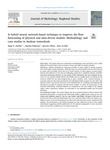A Hybrid Neural Network-Based Technique to Improve the Flow Forecasting of Physical and Data-Driven Models: Methodology and Case Studies in Andean Watersheds

Use este enlace para citar
http://hdl.handle.net/2183/24759
A non ser que se indique outra cousa, a licenza do ítem descríbese como Atribución-NoComercial-SinDerivadas 4.0 Internacional
Coleccións
- Investigación (ETSECCP) [826]
Metadatos
Mostrar o rexistro completo do ítemTítulo
A Hybrid Neural Network-Based Technique to Improve the Flow Forecasting of Physical and Data-Driven Models: Methodology and Case Studies in Andean WatershedsData
2020Cita bibliográfica
Juan F. Farfán, Karina Palacios, Jacinto Ulloa, Alex Avilés. A hybrid neural network-based technique to improve the flow forecasting of physical and data-driven models: Methodology and case studies in Andean watersheds, Journal of Hydrology: Regional Studies, Volume 27, 2020, 100652, ISSN 2214-5818, https://doi.org/10.1016/j.ejrh.2019.100652
Resumo
[Abstract] Study region The present study was conducted in the Machángara Alto and Chulco rivers, which belong to the Paute basin in the provinces of Azuay and Cañar in southern Ecuador.
Study focus
Andean watersheds are important providers of water supply for human consumption, food supply, energy generation, industrial water use, and ecosystem services and functions for many cities in Ecuador and in the rest of South America. In these regions, accurate quantification and prediction of water flow is challenging, mainly due to significant climatic variability and sparse monitoring networks. In the context of flow forecasting, this work evaluates the accuracy of two physical models (WEAP and GR2M) and two models based on artificial neural networks (ANN) that use meteorological data as input variables. Then, a hybrid technique is proposed, using the time series generated by the individual models as inputs of a new ANN. This approach aims to increase the accuracy of the simulated flow by combining and exploiting the information provided by physical and data-driven models. To assess the performance of the proposed methodology, statistical analyses are conducted for two case studies in the Andean region, where comparative analyses are performed for the individual models and the hybrid technique.
New hydrological insights
The results indicate that the proposed technique is able to improve the individual performance of physical and ANN-based models, yielding good results in the calibration and validation stages for the two case studies. Specifically, increases in NSE were observed from 0.64 to 0.99 in the MachÁngara Alto river, and from 0.88 to 0.99 in the Chulco river. Higher accuracy of the hybrid technique was observed for all evaluation criteria considered in the analyses. The performance of the hybrid technique was also reflected in terms of water supply and demand, suggesting possible applications for the regional management of water resources, where accurate flow predictions are of utmost importance.
Palabras chave
Neural networks
Hydrological models
Flow forecasting
Andean watersheds
Ecuador
Hydrological models
Flow forecasting
Andean watersheds
Ecuador
Versión do editor
Dereitos
Atribución-NoComercial-SinDerivadas 4.0 Internacional






